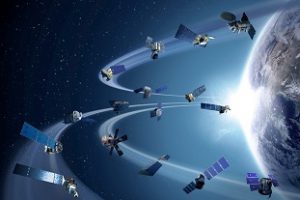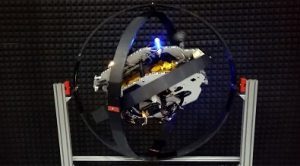[Editor’s Note: Mad Scientist Laboratory is pleased to present today’s guest post by returning blogger Ms. Marie Murphy, addressing the implication of space drones and swarms on space-based services critical to the U.S. Army. Ms. Murphy’s previous post addressed Virtual Nations: An Emerging Supranational Cyber Trend.]
 Drone technology continues to proliferate in militaries and industries around the world. In the deep future, drones and drone swarms may extend physical conflict into the space domain. As space becomes ever more critical to military operations, states will seek technologies to counter their adversaries’ capabilities. Drones and swarms can blend in with space debris in order to provide a tactical advantage against vulnerable and expensive assets at a lower cost.
Drone technology continues to proliferate in militaries and industries around the world. In the deep future, drones and drone swarms may extend physical conflict into the space domain. As space becomes ever more critical to military operations, states will seek technologies to counter their adversaries’ capabilities. Drones and swarms can blend in with space debris in order to provide a tactical advantage against vulnerable and expensive assets at a lower cost.

Space was recently identified as a battlespace domain in recognition of threats increasing at an unexpected rate and, in 2013, the Army Space Training Strategy was released. The functions of the Army almost entirely depend on space systems for daily and specialized operations, particularly C4ISR and GPS capabilities. “Well over 2,500 pieces of equipment… rely on a space-based capability” in any given combat brigade, so an Army contingency plan for the loss of satellite communication is critical.[I] It is essential for the Army, in conjunction with other branches of the military and government agencies, to best shield military assets in space and continue to develop technologies, such as outer space drones and swarms, to remain competitive and secure throughout this domain in the future.

Drone swarms in particular are an attractive military option due to their relative inexpensiveness, autonomy, and durability as a whole. The U.S., China, and Russia are the trifecta of advanced drone and drone swarm technology and also pose the greatest threats in space. In May 2018, Chinese Company CETC launched 200 autonomous drones,[II] beating China’s own record of 119 from 2017.[III] The U.S. has also branched out into swarm technology with the testing of Perdix drones, although the U.S. is most known for its use of the high-tech Predator drone.[IV]

Non-state actors also possess rudimentary drone capabilities. In January 2018, Syrian rebels attacked a Russian installation with 13 drones in an attempt to overwhelm Russian defenses. The Russian military was able to neutralize the attack by shooting down seven and bringing the remaining six down with electronic countermeasures.[V] While this attack was quelled, it proves that drones are being used by less powerful or economically resourceful actors, making them capable of rendering many traditional defense systems ineffective. It is not a far leap to incorporate autonomous communication between vehicles, capitalizing on the advantages of a fully interactive and cooperative drone swarm.

The same logic applies when considering drones and drone swarms in space. However, these vehicles will need to be technologically adapted for space conditions. Potentially most similar to future space drones, the company Swarm Technology launched four nanosats called “SpaceBees” with the intention of using them to create a constellation supporting Internet of Things (IoT) networks; however, they did so from India without FCC authorization.[VI] Using nanosats as examples of small, survivable space vehicles, the issues of power and propulsion are the most dominant technological roadblocks. Batteries must be small and are subject to failure in extreme environmental conditions and temperatures.[VII] Standard drone propulsion mechanisms are not viable in space, where drones will have to rely on cold-gas jets to maneuver.[VIII] Drones and drone swarms can idle in orbit (potentially for weeks or months) until activated, but they may still need hours of power to reach their target. The power systems must also have the ability to direct flight in a specific direction, requiring more energy than simply maintaining orbit.

There is a distinct advantage for drones operating in space: the ability to hide in plain sight among the scattered debris in orbit. Drones can be sent into space on a private or government launch hidden within a larger, benign payload.[IX] Once in space, these drones could be released into orbit, where they would blend in with the hundreds of thousands of other small pieces of material. When activated, they would lock onto a target or targets, and swarms would converge autonomously and communicate to avoid obstacles. Threat detection and avoidance systems may not recognize an approaching threat or swarm pattern until it is too late to move an asset out of their path (it takes a few hours for a shuttle and up to 30 hours for the ISS to conduct object avoidance maneuvers). In the deep future, it is likely that there will be a higher number of larger space assets as well as a greater number of nanosats and CubeSats, creating more objects for the Space Surveillance Network to track, and more places for drones and swarms to hide.[X]
 For outer space drones and drone swarms, the issue of space junk is a double-edged sword. While it camouflages the vehicles, drone and swarm attacks also produce more space junk due to their kinetic nature. One directed “kamikaze” or armed drone can severely damage or destroy a satellite, while swarm technology can be harnessed for use against larger, defended assets or in a coordinated attack. However, projecting shrapnel can hit other military or commercial assets, creating a Kessler Syndrome effect of cascading damage.[XI] Once a specific space junk removal program is established by the international community, the resultant debris effects from drone and swarm attacks can be mitigated to preclude collateral damage. However, this reduction of space junk will also result in less concealment, limiting drones’ and swarms’ ability to loiter in orbit covertly.
For outer space drones and drone swarms, the issue of space junk is a double-edged sword. While it camouflages the vehicles, drone and swarm attacks also produce more space junk due to their kinetic nature. One directed “kamikaze” or armed drone can severely damage or destroy a satellite, while swarm technology can be harnessed for use against larger, defended assets or in a coordinated attack. However, projecting shrapnel can hit other military or commercial assets, creating a Kessler Syndrome effect of cascading damage.[XI] Once a specific space junk removal program is established by the international community, the resultant debris effects from drone and swarm attacks can be mitigated to preclude collateral damage. However, this reduction of space junk will also result in less concealment, limiting drones’ and swarms’ ability to loiter in orbit covertly.
Utilizing drone swarms in space may also present legal challenges. The original governing document regarding space activities is the Outer Space Treaty of 1967. This treaty specifically prohibits WMDs in space and the militarization of the moon and other celestial bodies, but is not explicit regarding other forms of militarization, except to emphasize that space activities are to be carried out for the benefit of all countries. So far, military space activities have been limited to deploying military satellites and combatting cyber-attacks. Launching a kinetic attack in space would carry serious global implications and repercussions.
Such drastic and potentially destructive action would most likely stem from intense conflict on Earth. Norms about the usage of space would have to change. The Army must consider how widely experimented with and implemented drone and swarm technologies can be applied to targeting critical and expensive assets in orbit. Our adversaries do not have the same moral and ethical compunctions regarding space applications that the U.S. has as the world’s leading democracy. Therefore, the U.S. Army must prepare for such an eventuality. Additionally, the Army must research and develop a more robust alternative to our current space-based GPS capability. For now, the only war in space is the one conducted electronically, but kinetic operations in outer space are a realistic possibility in the deep future.
Marie Murphy is a rising junior at The College of William and Mary in Virginia, studying International Relations and Arabic. She is currently interning at Headquarters, U.S. Army Training and Doctrine Command (TRADOC) with the Mad Scientist Initiative.
______________________________________________________
[I] Houck, Caroline, “The Army’s Space Force Has Doubled in Six Years, and Demand Is Still Going Up,” Defense One, 23 August 2017.
[II] “China’s Drone Swarms,” OE Watch, Vol. 8.7, July 2018.
[III] “China Launches Drone Swarm of 119 Fixed-Wing Unmanned Aerial Vehicles,” Business Standard, 11 June 2017.
[IV] Atherton, Kelsey D., “The Pentagon’s New Drone Swarm Heralds a Future of Autonomous War Machines,” Popular Science, 17 January 2017.
[V] Hruska, Joel, “Think One Military Drone is Bad? Drone Swarms Are Terrifyingly Difficult to Stop,” Extreme Tech, 8 March 2018.
[VI] Harris, Mark, “Why Did Swarm Launch Its Rogue Satellites?” IEEE Spectrum, 20 March 2018.
[VII] Chow, Eugene K., “America Is No Match for China’s New Space Drones,” The National Interest, 4 November 2017.
[VIII] Murphy, Mike, “NASA Is Working on Drones That Can Fly In Space,” Quartz, 31 July 2015.
[IX] Harris, Mark, “Why Did Swarm Launch Its Rogue Satellites?” IEEE Spectrum, 20 March 2018.
[X] “Space Debris and Human Spacecraft,” NASA, 26 September 2013.
[XI] Scoles, Sarah, “The Space Junk Problem Is About to Get a Whole Lot Gnarlier,” WIRED, July 31, 2017.



